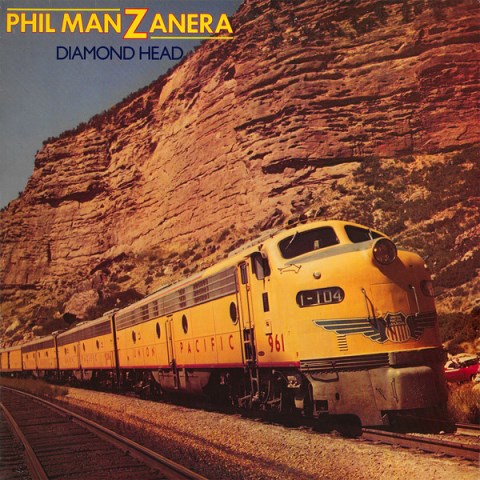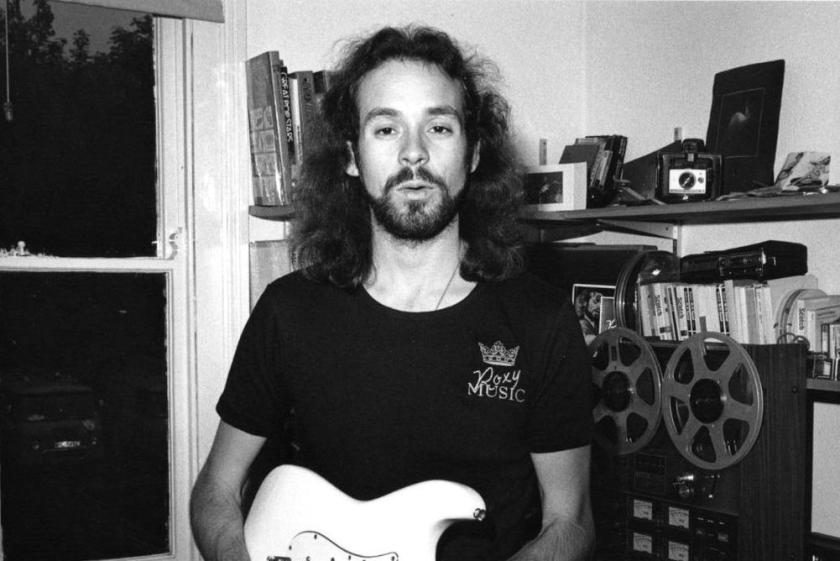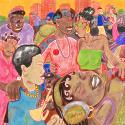Diamond Head was Roxy Music guitarist Phil Manzanera’s first solo album. Released in May 1975 and recorded the previous December and January during a lull in his parent band’s activities, it hit shops between Roxy’s Country Life and Siren albums. Singer Bryan Ferry had done a short solo tour in December 1974 which culminated with a show at The Royal Albert Hall where he was backed by an orchestra. Manzanera took a different tack.
Playing alongside him on Diamond Head were Eddie Jobson, Andy Mackay, Paul Thompson and John Wetton – sans Ferry, Manzanera assembled the whole of the then-current Roxy line-up. Brian Eno was also on board. He had left Roxy in July 1973. Others gathered in the studio with Manzanera included bassist and Eno-associate Brian Turrington (from The Winkies), Bill MacCormick (who had been on Eno’s Here Come The Warm Jets album in 1973) and Robert Wyatt (MacCormick played with him in Matching Mole and had been in Manzanera’s pre-Roxy band Quiet Sun).
 As well as being a quasi-Roxy Music album, the newly reissued Diamond Head gathered some of British art-rock’s heavy hitters. But it has not received much attention. It was recorded concurrently with an album by the reformed Quiet Sun which was released in August 1975, so it’s fair to wonder whether Manzanera was staking his claim as a pivotal figure in the more leftfield areas of British rock. He later said “unbeknownst to my management company I recorded two albums in the studio time allocated for one album.”
As well as being a quasi-Roxy Music album, the newly reissued Diamond Head gathered some of British art-rock’s heavy hitters. But it has not received much attention. It was recorded concurrently with an album by the reformed Quiet Sun which was released in August 1975, so it’s fair to wonder whether Manzanera was staking his claim as a pivotal figure in the more leftfield areas of British rock. He later said “unbeknownst to my management company I recorded two albums in the studio time allocated for one album.”
Roxy were one aspect of Manzanera’s already top-notch CV. His first production credit had been a joint one with Eno on John Cale’s 1974 Fear album. The partnership continued that year for Eno’s Taking Tiger Mountain (By Strategy) album. He also played on Ferry’s first solo album, 1973’s These Foolish Things, and Mackay’s 1974 oddity In Search of Eddie Riff but Manzanera carried the can on Diamond Head.
One track, the dramatic “East Of Echo” is by and credited to Quiet Sun. Obviously there was a bleed between the different hats Manzanera was wearing; on his solo album he pointed to another aspect of what he was doing. The real jolt arrives with the extraordinary “Miss Shapiro” (an oblique cut-up lyric tribute to Helen?), an Eno-sung, Eno-Manzanera co-write with elements of Roxy’s “The Numberer” which would have comfortably slotted onto Eno’s first two solo albums: another bleed. The same goes for the also-terrific “Big Day”.
 Once the surprise of discovering these Eno-slanted outings wears off, it becomes impossible not to reconsider Manzanera’s role in both Roxy and Eno’s early solo work. His role as a prime artistic enabler and mover needs recognising. Further proof of this comes with Diamond Head’s lovely, soaring opening track, “Frontera”. Sung in Spanish by Robert Wyatt as a nod to Manzanera’s background, it has a dreaminess nodding forward to the sound of reformed Roxy Music of August 1978 and later. That it was the solitary album track extracted as a single and issued only in Germany confirms that the solo Manzanera wasn’t seen as a commercial goer.
Once the surprise of discovering these Eno-slanted outings wears off, it becomes impossible not to reconsider Manzanera’s role in both Roxy and Eno’s early solo work. His role as a prime artistic enabler and mover needs recognising. Further proof of this comes with Diamond Head’s lovely, soaring opening track, “Frontera”. Sung in Spanish by Robert Wyatt as a nod to Manzanera’s background, it has a dreaminess nodding forward to the sound of reformed Roxy Music of August 1978 and later. That it was the solitary album track extracted as a single and issued only in Germany confirms that the solo Manzanera wasn’t seen as a commercial goer.
In the reissue's liner notes, the Manzanera of the time is quoted as saying “The things I wanted to do are all there; the little cameos like the dance number, the three minute type guitar instrumental, the classical number. Certain of the songs were written with suitable people in mind and eventually it all came off.” That “guitar instrumental” “Lagrima” is especially interesting as it features Andy McKay’s oboe and suggests where Roxy’s “The Pride and the Pain” may have gone next. As this confirms, Diamond Head is not stylistically cohesive.
Before Diamond Head’s release, Phil Manzanera was back in Roxy Music and on road with them in America over February and March 1975. He did not pursue the paths heard on Diamond Head. Mysteriously, for no given reason, the new reissue has a different cover image to the original album (pictured above) and is very washed out. However, give this a listen – it’s a treat.
- Next week: Creedence Clearwater Revival at Woodstock
- Read more reissue reviews on theartsdesk
- Kieron Tyler’s website















Add comment